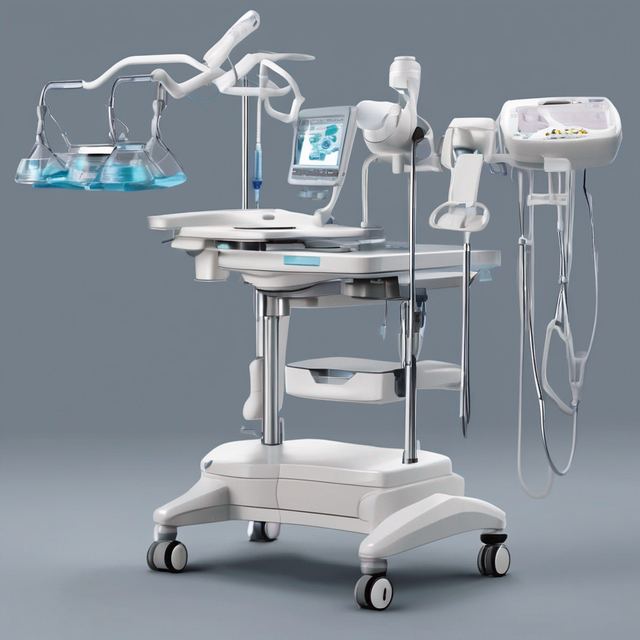A comprehensive introduction to medical equipment and its importance in health care

medical equipment
A comprehensive introduction to medical equipment and its importance in health care
Medical equipment is crucial in diagnosing and treating diseases and injuries and providing effective health care. Medical equipment includes a variety of tools, devices, and accessories used in the medical field. This equipment varies in size, function, and technology used.
It is also important that medical equipment be used correctly in accordance with medical guidelines and directives, and that foresters choose appropriate equipment approved by the competent regulators. The equipment must be maintained regularly and the necessary tests and adjustments must be carried out to ensure its proper and proper performance.,
In this article we will highlight the components of medical equipment, its various types, its classifications, basic medical equipment, important equipment in the medical field, and emergency medical equipment.
What are the components of medical equipment?
Medical equipment consists of a group of parts and components that work together to achieve a desired purpose. Among the common components of medical equipment are:
Medical devices: includes medical imaging devices such as X-rays, MRI and CT scans. Used for diagnosis and monitoring of patients' condition. They also include blood pressure monitoring, heart rate, blood oxygen level, blood sugar measurements, and ECG.
Medical tools: includes surgical and manual instruments such as scalpel, scissors, tongs, and surgical sewing tools. Used in surgical operations and other medical procedures.
Medical supplies: includes medical gloves, medical masks, disinfectant materials, and protective clothing. Used to maintain hygiene, sterilization, and protection in the medical environment.
Consumables: Includes bags, marks, tubes, needles, and prosthetics. Used in the preparation and organization of medical materials and tools.
Auxiliary medical devices: include ventilators, artificial heart devices, defibrillators, blood purifiers, and blood pressure regulators. Used to improve patients' condition and facilitate health care.
Types of medical equipment
Medical equipment includes a wide range of different types. Here are some examples of these types:
Medical imaging devices: include X-rays, magnetic resonance imaging (MRI), ultrasound, CT scan, and nuclear imaging.
Measuring and monitoring devices: such as monitoring blood pressure, heart rate, blood oxygen saturation, temperature, and blood sugar level.
Respiratory and anesthesia devices: such as ventilators, oxygen delivery devices, and patient anesthesia devices.
Surgical and surgical instruments: such as scalpel, scissors, forceps, suture tools, fluoroscopy devices, and drug pumps.
Cardiovascular devices: such as ECG devices, cardiac endoscopy devices, and arterial catheterization devices.
Electrotherapy devices: such as electrical balance devices, electrical nerve stimulation devices, and ultrasound therapy devices.
Physical therapy and rehabilitation devices: such as heat and cold therapy devices, sound wave therapy devices, and therapeutic exercise devices.
Blood and kidney purification devices: such as dialysis devices, blood filtration devices, and liver purification devices.
Radiology and laser devices: such as medical laser devices, X-ray devices, and laser devices to correct vision.
Other medical tools and equipment: These include medical gloves, bowls, needles, medical masks, cotton swabs, adhesive tapes, surgical kits, and medical measuring and recording tools.
Classifications of medical equipment (single or multiple uses)
Medical equipment is classified into two main categories: single-use equipment and frequently used equipment.
- Single-use equipment: includes equipment that is made for use only once and is disposed of after the first use. This type of equipment enhances safety and reduces the risk of accumulated infection. Examples of this equipment include:
Medical gloves: used to provide a protective barrier between the healthcare provider and the patient and reduce transmission of infection.
Needles: They are used to give injections and withdraw blood samples and are disposed of after one use.
Medical masks: They are used to provide a protective barrier for the mouth and nose and prevent the transmission of infectious particles.
- Repeatedly used equipment: This includes equipment that can be washed, sterilized, and used many times before being disposed of. This type of equipment contributes to reducing costs and waste resulting from single-use equipment. Examples of this equipment include:
Sterile surgical instruments: include scalpels, scissors, forceps, and other instruments used in surgical operations, and they are sterilized after each use.
Blood pressure measuring devices: such as stethoscopes and blood pressure measuring devices, which are sterilized between patients.
Glucose measuring devices: They are used to measure blood sugar levels, and they are sterilized between patients.
What is essential medical equipment?
Essential medical equipment includes that which is relied upon to provide basic health care, diagnosis, and treatment.
Examples of basic medical equipment include:
Biometric devices: such as monitoring blood pressure, measuring heart rate, and monitoring blood oxygen saturation.
Diagnostic tools: such as a microscope, ear and eye examination tools, and skin examination devices.
Medical imaging devices: such as X-ray machines, (CT scans), and magnetic resonance imaging machines (MRI).
Important equipment in the medical field
In addition to basic equipment, there is a group of important equipment in the medical field that contributes to improving the quality of health care and accelerating medical processes. These equipment include:
Patient monitoring systems: These include devices that measure pulse rate, blood pressure, oxygen saturation, and heart monitoring to help doctors monitor patients’ condition.
Ventilator: Used to provide respiratory support to patients who have difficulty breathing.
Blood purification devices: They are used in filtration and blood purification processes for patients suffering from kidney disease or kidney failure.
Emergency medical equipment
Emergency equipment plays a vital role in providing quick and effective medical care in health emergencies. Emergency equipment includes:
Artificial lungs (Ventilators).
Defibrillator.
Cardiac Monitor.
Portable respirator (Bag Valve Mask).
Cardiopulmonary resuscitation (CPR) device.
Portable oxygen device.
These are just some of the basic equipment used to help patients in medical emergencies.
In general, medical equipment plays a crucial role in providing high-quality healthcare and improving patients' health. Technological developments in this field continue to enhance the availability of innovative and effective medical equipment, contributing to the advancement of medicine and improving treatment outcomes for patients.